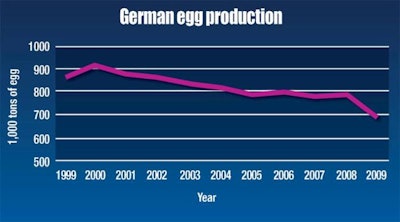
By law, the EU’s ban on conventional cages for housing laying hens took effect on January 1, but according to the European Commission, estimates of as many as 46 million hens, around 14 percent of the total, were still in conventional cages at the start of the year in the EU. Egg producers who have already converted to approved alternative housing systems are upset with government officials because they are incurring higher costs of production than producers who are still housing hens in cages. German egg producers have been at the same type of disadvantage since January 1, 2009, when a ban on housing hens in cages took effect in Germany.
Cages and politics
The Green Party in Germany was founded in 1980 and it gradually rose in prominence until it participated in a coalition federal government from 1998 until 2005. While being best known for backing so-called pro-environment causes like being against nuclear power, the German Green Party is also pacifist and opposed to housing laying hens in cages.
The legislation passed by the European Parliament banned cages for housing laying hens on January 1, 2012, but it also allowed for member states to impose the ban at an earlier date and they could enact stricter standards for hen housing within their own borders. The EU cage ban legislation passed 12 years before it was scheduled to take effect, but it took nine years for the EU to set standards for what would be considered acceptable housing for hens and this left egg producers only three years prior to the ban to convert. Included among the acceptable forms of housing for hens in the EU was the enriched colony, which may become the primary means of housing hens in the U.S. if the H.R. 3798 is enacted as law.
The German Bundestag took advantage of the both the option to enforce the cage ban at an earlier date, three years sooner, and to set a higher standard for hen housing than was enacted for the rest of the EU. Dr. Hans-Wilhelm Windhorst, professor emeritus, University of Vechta, Germany, described to the audience at the Iowa Poultry Association Fall Banquet how the Bundestag’s decisions have negatively impacted German egg producers.
Colony nests
German authorities decided that EU-approved enriched colonies could not be used in Germany to house hens. Instead, an alternative type of enclosure the Kleingruppenhaltungen, colony nest, was approved. Colony nests were required to provide at least 124 square inches per hen up to 4.4 pounds in weight, and 139 square inches per hen for birds weighing over 4.4 pounds. Single enclosures had to be at least 20.6 square feet in size, at least 23.6 inches high at the feed trough, and be at least 19.7 inches high everywhere else. No more than 60 hens were permitted per enclosure.
The cage ban went into effect on January 1, 2009, but that wasn’t the end of the changes for German egg producers. Some activists groups were still not happy with colony nests for housing layers because they saw these as just a big cage with a few enrichments. Windhorst said that the activist groups put enough pressure on leading German food retailers to cause them to announce in 2010 that they wouldn’t buy eggs from hens housed in colony nests. This move forced some egg producers who had already invested in colony nests to replace their conventional cages to switch once again to barn systems.
Economic impact
The conventional cage ban has resulted in barn systems becoming the predominant means of housing laying hens in Germany, with nearly two thirds of hens in barn systems in 2010 (see graph 1). Egg production fell in Germany by 22.5 percent from 2000 through 2009. It fell by 11.6 percent in 2009, the year the cage ban went into affect, from the year before (see graph 2). In 2002, Germany produced 74 percent of the eggs that it consumed and this dropped to 55 percent by 2010. Egg products are not the only thing imported into Germany, shell egg imports increased by 37.4 percent from 2008 to 2010.
Windhorst said that in 2010, wholesale egg prices in Germany peaked at around $2.47 per dozen at the farm level due to a shortage around Easter, but crashed to around $1.02 per dozen by mid-summer. From 2000 to 2010 the number of egg farms in Germany dropped by 14.6 percent, and the number of hens housed dropped by 10.8 percent (see Graphs 3 and 4).
Even with the cage ban taking affect for the rest of the EU at the start of 2012, German egg producers are still not competing on a level playing field. Some EU egg producers in other countries still have hens in traditional cages and German producers are not allowed to use enriched colony housing. The negative impact of different housing rules for different countries in the EU could be replicated in the U.S. as the ballot initiatives passed in California and other states take effect.





.jpg?auto=format%2Ccompress&fit=crop&h=167&q=70&w=250)











